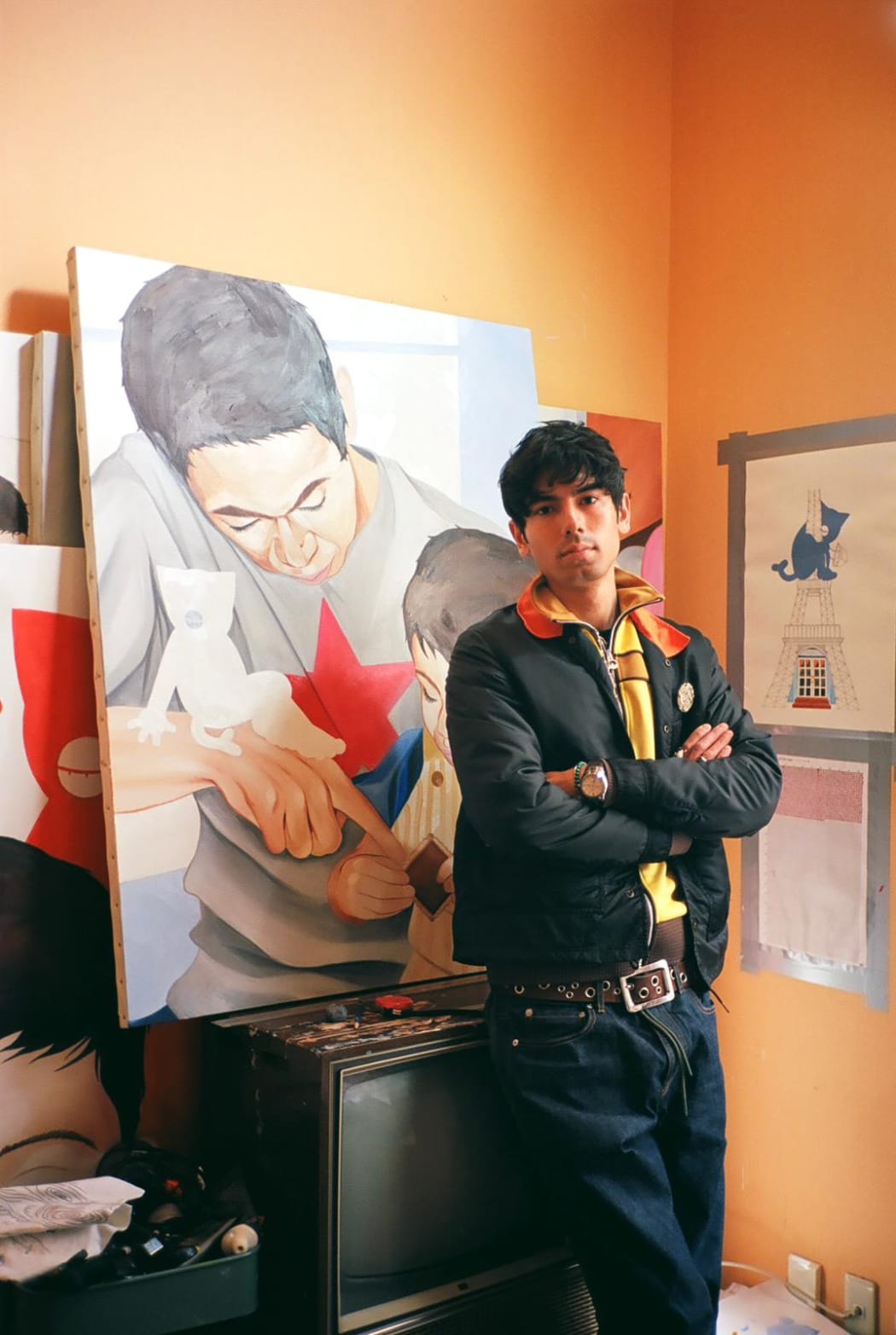
From the time he could hold a pen, French/Japanese artist Victor Takeru (born in 1998) dreamed of becoming a cartoonist. However, he soon realized that he lacked the patience required for crafting stories and decided to pursue a career as an artist. His style is an intriguing fusion of influences, drawing from Japanese (manga) artists like Matsumoto Taiyo, contemporary artists such as David Hockney and Claire Tabouret, and the dynamic world of street art, resulting in a unique bicultural approach.
Sato Gallery welcomes its youngest artist, Victor Takeru, into the family. As of October 27th, Takeru's artworks will be showcased in Rotterdam, and we had the opportunity to sit down with him and discuss his young but promising artistic journey.
Growing up in Paris, Victor Takeru experienced a sense of being "different." Living between two distinct cultures offered enrichment but came with its challenges. While his childhood friends spent their summers in the sunny south of France, Victor often found himself in the more remote and less eventful Nagoya, visiting family for weeks. Although it could be frustrating at times, at 25 years old, he reflects with gratitude.
He notes, "I have many friends who are of mixed heritage but don't speak a word of Japanese because one of their parents gave up."
Born at the end of the 1990s, Victor Takeru's paintings offer a glimpse into the culture of today's twenty-somethings and contemporary Tokyo. Infused with a touch of nostalgia, his art captures the essence of long summer days, moments of boredom, and bursts of excitement. His canvases take us on car trips, invite us to a tabi shoed siesta, and offer a glimpse into intimate scenes, including a portrayal of a toilet scene. iPhones and cigarettes, vibrant colors, and the ever-present cat character, which Victor views as an alter ego, offer a link to the world of street art.
Recently, he has shifted his focus towards more intimate creations, particularly self-portraits. In Rotterdam, he will be unveiling a series of these personal close-ups.
CZ: Judging from your Instagram you are very productive.
VT: I have been very busy, especially this year. This show in Rotterdam is my 4th this year.
I feel guilty if I don’t work. I constantly need to prove myself that I’m good at what I do. I didn’t go to art school. Everything I do I taught myself. My identity has been shaped by my work, it gives me confidence. When I finish and when I’m satisfied with the canvas, it feels so good.
CZ: Can you tell us more about the subjects of your work?
VT: I used to paint a lot of memories. I’m a very nostalgic person. Lately I’m into self-portraits. I wasn’t confident about myself my whole life and I realized that if I would make a lot of self portraits I might come to peace with myself.
I have always hidden the eyes of the characters I paint. We see people and they bring something although the work doesn’t explicitly show emotions.
CZ: Is it strange to make your own face in detail?
VT: It is. You know in all the paintings I make the eyes are closed. I have run away from many responsibilities and I think this is my way of acknowledging. I’m closing my eyes for the bad side of something. You can tell a lot by looking into someone’s eyes. In my paintings no-one shows. I have always hidden the eyes of the characters I paint. We see people and they bring us something although the work doesn’t explicitly show emotions. You don’t know how to feel as a spectator.

CZ: What is your ambition with your art?
VT: Being shown in a modern art museum. I have been putting a lot of pressure on myself. When I like an artist I always look up what that person was doing when they were my age, and I compare myself. It is part of our human being to compare, right? I mean, we also compare the prices of the food we buy. I compare myself with other artists all the time.
CZ: Are you strict on yourself?
VT: I'm a self taught artist, and I need discipline. Every morning when I wake up I do a 30 minute walk to change my mind. I paint in the room where I sleep, so I need to freshen up in order to come back to my house to work.
I listen to podcasts while I paint, mostly on art. And I use YouTube tutorials to learn how to do a certain technique or on how to use oil paint. You can learn to cook and to paint.
CZ: Do you think Japanese culture is sentimental but not emotional?
VT: Showing your emotion is not a good thing to do in Japanese culture, so that might be true. But I grew up in France and I think I’m closer to French culture, where you give your opinion at any time. When I was younger, I always thought I was different. Japanese. I had a certain respect for elderly people that is uncommon in France. But since I’m living in Japan I realize how French I am!

CZ: Are you considered an emotional person in Japan?
VT: I guess so. Like every human being I have emotions, but being a good human means to hide and to control your emotions. I want to put them in my art.
A lot of artists say they don’t think of anything when they work. To me painting is a moment to think of the bad things I did and the memories that I have. Art is where I can put my emotions.
CZ: How does the Japanese audience respond to your work compared with the French audience?
VT: I can see that Japanese people like art that is easy to digest. Efrain (ed Vivas Hattori) for example fits much better with the European audience. The Japanese, and the whole Asian market, are more interested in ‘commercial’ work, which is easier to understand. You don’t have to think too much when you look at it. That’s why Takashi Murakami and Takeru Amano are successful, because you don’t have to think of the meaning. It’s merely aesthetic. I do think there has been a slight shift recently. You see a bit more abstract art. It’s an interesting market to follow.


